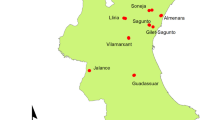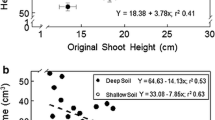Abstract
The chemical composition of wood is closely related to its growing conditions, such as soil temperature and water. Four different types of soil warming and precipitation exclusion treatments were used to simulate the underground response and adaptability of Chinese fir to global warming. The compaction method was used to reclaim the Chinese fir soil from the nearby woodland to ensure that the soil bulk density was as consistent as possible. The chemical constituents of Chinese fir wood were studied by taking Chinese fir discs at breast height of 1.3 m. With changing the growth environment, the content of different extracts and the chemical composition of Chinese fir have changed. The cellulose content of Chinese fir increased significantly with precipitation exclusion − 50%. The organic extract content of Chinese fir increased in different degrees under soil warming and precipitation exclusion, which may be related to the accumulation of organic matter content and be beneficial to the improvement of the biomass of Chinese fir. Due to the change of temperature and water content in soil, the internal adaptability of Chinese fir wood cellulose like crystalline zone, overall orderliness also may decrease. Precipitation exclusion − 50% still has the greatest impact on it. The soil warming and precipitation exclusion can inhibit lignin synthesis of Chinese fir. The lignin condensation index decreased with the decrease of lignin content, possibly due to the change of syringyl lignin content. Experiments show that the underground parts of terrestrial ecosystems may provide positive effects from global warming, although the extent of such consequences is uncertain.




Similar content being viewed by others
References
Abdul KHPS, Davoudpour Y, Islam MDN, Mustapha A, Sudesh K, Dungani R, Jawaid M (2014) Production and modification of nanofibrillated cellulose using various mechanical processes: a review. Carbohydr Polym 99:649–665
Bonan GB, Levis S (2010) Quantifying carbon–nitrogen feedbacks in the community land model (CLM4). Geophys Res Lett 37(7):L07401
Carrillo F, Colom X, Suñoll JJ, Saurina J (2004) Structural FTIR analysis and the thermal characterization of lyocell and viscose-type fibers. Eur Polym J 40:2229–2234
Cavaleri MA, Reed SC, Smith WK, Wood TE (2015) Urgent need for warming experiments in tropical forests. GCB Bioenergy 21(6):2111–2121
Chandel AK, Antunes FAF, Terán-Hilares R, Cota J, Ellilä S, Silveira MHL (2018) Chapter 5—bioconversion of hemicellulose into ethanol and value-added products: commercialization, trends, and future opportunities. In: Advances in sugarcane biorefinery, pp 97–134
Cheng H, Feng S, Jia X, Li Q, Zhou Y, Ding C (2013) Structural characterization and antioxidant activities of polysaccharides extracted from epimedium acuminatum. Carbohyd Polym 92(1):63–68
Cunningham S, Read J (2002) Comparison of temperate and tropical rainforest tree species: photosynthetic responses to growth temperature. Oecologia 133(2):112–119
Faix O (1991) Condensation indices of lignins determined by FTIR spectroscopy. Holz als Roh- und Werkstoff 49:356
Falkehag IS, Marton J, Adler E (1966) Chromophores in Kraft Lignin. American Chemical Society, Washington, DC, pp 75–89
Feng JX, Xiong DC, Shi SZ, Xu CS, Zhong BY, Deng F, Chen YY, Chen GS, Yang YS (2017) Effects of soil warming on the ecophysiological properties of the fine roots of Chinese fir (Cunninghamia lanceolata) seedlings. Acta Ecol Sin 37(1):35–43
Grant RF, Rochette P (1994) Soil microbial respiration at different water potentials and temperatures: theory and mathematical modeling. Soil Sci Soc Am J 58(6):1681–1690
Heimann M, Reichstein M (2008) Terrestrial ecosystem carbon dynamics and climate feedbacks. Nature 451(7176):289–292
IPCC Climate Change (2013) The physical science basis. In: Contribution of working group I to fifth assessment report of the intergovernmental panel on climate change. Cambridge University Press, Cambridge
Li XJ, Liu XF, Lin CF, Chen SD, Xiong DC, Lin WS, Xu C, Xie JS, Yang YS (2017) Effects of experimental soil warming on plant biomass allocation during the early stages of succession in a subtropical forest in China. Acta Ecol Sin 37(1):25–34
Melillo JM, Steudler PA, Aber JD, Newkirk K, Lux H, Bowles FP, Catricala C, Magilla A, Ahrens T, Morrisseans S (2002) Soil warming and carbon-cycle feedbacks to the climate system. Science 298(5601):2173–2176
Nelson ML, O’Connor RT (1964) Relation of certain infrared bands to cellulose crystallinity and crystal lattice type. Part I. Spectra of types I, II, III and amorphous cellulose. J Appl Polym Sci 8:1311–1324
Oh SY, Yoo DI, Shin Y, Seo G (2005) FTIR analysis of cellulose treated with sodium hydroxide and carbon dioxide. Carbohydr Res 340:417–428
Osong SH, Norgren S, Engstrand P (2016) Processing of wood-based microfibrillated cellulose and nanofibrillated cellulose, and applications relating to papermaking: a review. Cellulose 23(1):93–123
Pandey KK (1999) A study of chemical structure of soft and hardwood and wood polymers by FTIR spectroscopy. J Appl Polym Sci 71:1969–1975
Pandey KK, Pitman AJ (2004) Examination of the lignin content in a softwood and a hardwood decayed by a brown-rot fungus with the acetyl bromide method and Fourier transform infrared spectroscopy. J Polym Sci Part A:Polym Chem 42:2340–2346
Robertson AR (1977) The CIE 1976 color-difference formulae. Color Res Appl 2(1):7–11
Rodrigues J, Faix O, Pereira H (1998) Determination of lignin content of Eucalyptus globulus wood using FTIR spectroscopy. Holzforschung 52:46–50
Rousk J, Frey SD, BååTh E (2012) Temperature adaptation of bacterial communities in experimentally warmed forest soils. Glob Change Biol 18(10):3252–3258
Saleska SR (2003) Carbon in amazon forests: unexpected seasonal fluxes and disturbance-induced losses. Science 302(5650):1554–1557
Schindlbacher A, Rodler A, Kuffner M, Kitzler B, Sessitsch A, Zechmeister BS (2011) Experimental warming effects on the microbial community of a temperate mountain forest soil. Soil Biol Biochem 43(7):1417–1425
Streit K, Hagedorn F, Hiltbrunner D, Portmann M, Saurer M, Buchmann N (2013) Soil warming alters microbial substrate use in alpine soils. Glob Change Biol 20(4):1327–1338
Takabe T, Uchida A, Shinagawa F, Terada Y, Kajita H, Tanaka Y (2008) Overexpression of DnaK from a halotolerant cyanobacterium Aphanothece halophytica enhances growth rate as well as abiotic stress tolerance of poplar plants. Plant Growth Regul 56(3):265–273
Tucker CL, Jennifer B, Elise P, Kiona O (2013) Does declining carbon-use efficiency explain thermal acclimation of soil respiration with warming? Glob Change Biol 19(1):252–263
Výbohová E, Kučerová V (2013) The changes of selected characteristics of cellulose at water prehydrolysis of poplar (Populus tremula L.) wood. Acta Facultatis Xylologiae 55(2):77–86
Waliszewska H, Zborowska M, Waliszewska B, Borysiak S, Antczak A, Czekała W (2018) Transformation of Miscanthus and Sorghum cellulose during methane fermentation. Cellulose 25:1207–1216
Waliszewska B, Mleczek M, Zborowska M, Goliński P, Rutkowski P, Szentner K (2019) Changes in the chemical composition and the structure of cellulose and lignin in elm wood exposed to various forms of arsenic. Cellulose 26(10):6303–6315
Way DA, Oren R (2010) Differential responses to changes in growth temperature between trees from different functional groups and biomes: a review and synthesis of data. Tree Physiol 30(6):669–688
Xie J, Qi J, Huang X, Zhou N, Hu Y (2015) Comparative analysis of modern and ancient buried Phoebe zhennan wood: surface color, chemical components, infrared spectroscopy, and essential oil composition. J For Res 26(2):501–507
TAPPI-T 204 cm-07 (2007) Solvent extractives of wood and pulp. Standards Technical Association of the Pulp and Paper Industry
TAPPI-T 17 wd-70 (1970) Cellulose in Wood and Pulp. Standards Technical Association of the Pulp and Paper Industry
TAPPI-T 222 om-02 (2002) Acid-insoluble lignin in Wood and Pulp. Standards Technical Association of the Pulp and Paper Industry
TAPPI-T 9 wd-75 (1975) Holo-cellulose in Wood. Standards Technical Association of the Pulp and Paper Industry
TAPPI-T 212 om-02 (2002) One percent sodium hydroxide solubility of wood and pulp. Standards Technical Association of the Pulp and Paper Industry
Yang HK, Wen SF, Xiao FM, Fan GR (2016) Study on the chemical compositions of ethanol extraction from Chenshan Red-heart Chinese fir. South China For Sci 44(01):35–37
Zachary T, Aanderud JH, Richards TS, Jeremy JJ (2010) A shift in seasonal rainfall reduces soil organic carbon storage in a cold desert. Ecosystems 13(5):673–682
Zborowska M, Babiński L, Waliszewska B, Prądzyński W (2007) Qualitative characteristics of cellulose from archaeological oak (Quercus sp.) wood. Wood Res 52(3):33–40
Zhang JG, Loris L, Gözaydın G, Dyson PJ, Yan N (2018) Single-step conversion of lignin monomers to phenol: bridging the gap between lignin and high-value chemicals. Chin J Catal 39(9):1445–1452
Acknowledgments
This paper is supported by the National Major Basic Research Project (2014CB954003) and the National Natural Science Foundation (31500408).
Author information
Authors and Affiliations
Corresponding authors
Ethics declarations
Conflict of interest
To the best of our knowledge, the named authors have no conflict of interest, financial or otherwise.
Additional information
Publisher's Note
Springer Nature remains neutral with regard to jurisdictional claims in published maps and institutional affiliations.
Rights and permissions
About this article
Cite this article
Sheng, J., Chen, J., Liu, C. et al. Changes in the chemical composition of young Chinese fir wood exposed to different soil temperature and water content. Cellulose 27, 4067–4077 (2020). https://doi.org/10.1007/s10570-020-03039-3
Received:
Accepted:
Published:
Issue Date:
DOI: https://doi.org/10.1007/s10570-020-03039-3




